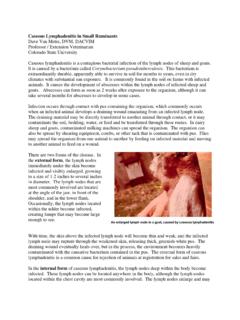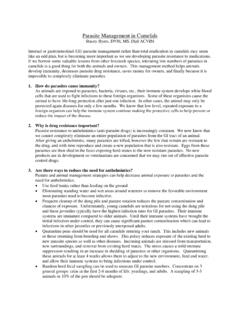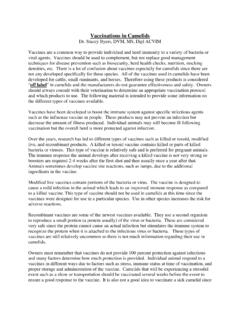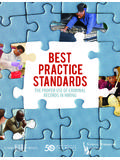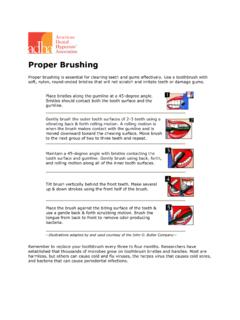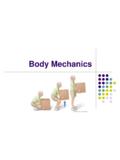Transcription of Proper Use of the Bovine Esophageal Feeder: Tubing a Calf ...
1 Proper Use of the Bovine Esophageal feeder : Tubing a Calf Ragan Adams, DVM, CSU Extension Eric McPhail, MS, CSU Extension The Bovine Esophageal feeder was designed to treat sick calves with fluids and to administer colostrum to newborn calves. Proper technique is critical to success. The Esophageal feeder can cause damage to the animal if used improperly. Start with the properly sized Bovine Esophageal feeder . They can be found at the local feed store in three different sizes: 1) calves, 2) yearling steers and 3) adult cows. The calf Esophageal feeder consists of a stainless steel or plastic ball probe with an attaching plastic tube and reusable plastic pouch or bottle which holds the fluid.
2 (Fig 1.) Prior to Tubing the calf each time, examine the feeder to be sure it is clean and undamaged. The steel probe looks more intimidating to the operator, but it is less likely to kink, twist or turn back on itself than the plastic probe. The length of the tube and size of the calf will dictate how far to insert the tube. Measure this distance by comparing the tube to the distance between the mouth of the calf and the point of the shoulder (x). (Fig 2) This is the approximate distance that the tube should be inserted; if you prefer, you can mark this distance on the tube.
3 Fig. 1. Fig. 2. The calf should be positioned so that the fluid administered is not aspirated into the lungs. It is preferable to tube the calf while it is standing. Put its rear into a corner and hold its head between your legs. (Fig 3) If the calf cannot stand, sit it up on its sternum and hold the head between your legs (Fig 4). Fig. 3. Fig. 4. To insure that no fluid runs into the mouth of the calf that may be inhaled into its lungs, the rigid part of the feeder should be removed from the plastic pouch or bottle or the plastic tube must be kinked off while the tube is passed.
4 Fig. 5 Moisten theend of the feeder with colostrum or lubricant to make the bulb slippery. Stimulate the calf to open its mouth by putting pressure on its gums. Insert the probe end. (Fig 5). This rounded end when placed in the calf s mouth at the back of its throat will stimulate the calf to swallow. Wait patiently. Once the calf swallows the end of the feeder , slide the tube gently down the esophagus to the mark that was placed previously on the tube. Prior to administering the fluid, check that you feel the tube in the esophagus on the left side of the calf s neck.
5 (Fig 6) You will distinctly feel two tube like structures in the neck. The trachea or windpipe is firm and has rings or ridges. The tube in the esophagus is firm but smooth. You can move the tube back and forth to identify it in the esophagus. (Fig 7) Fig. 6. Fig. 7. Administer the fluid by raising the bag above the calf and allowing the fluid to flow by gravity. (Fig 8) The calf will begin to move about when it feels pressure in its filling rumen. Do not remove the tube until the fluid has had sufficient time to get to the rumen. Fig.
6 8. Prior to removing the tube, kink off the tube or remove the bottle. Gently pull the tube out in one swift motion holding the calf as still as possible. Immediately wash the tube and feeder in hot soapy water. Follow with a chlorine and hot water rinse. When feeding colostrum you must remove a fluid of fat and protein that tends to congeal in the feeders. Proper cleaning and disinfection of the feeder is very important.


